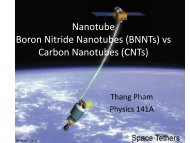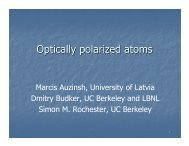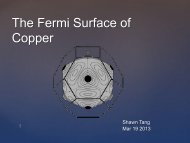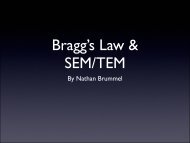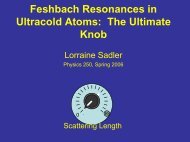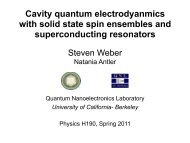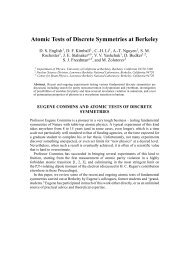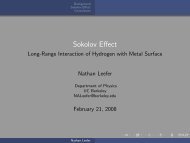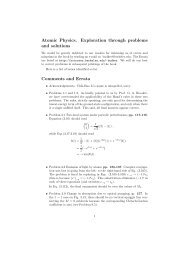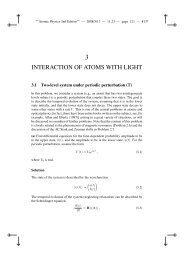Resonant nonlinear magneto-optical effects in atomsâ - The Budker ...
Resonant nonlinear magneto-optical effects in atomsâ - The Budker ...
Resonant nonlinear magneto-optical effects in atomsâ - The Budker ...
Create successful ePaper yourself
Turn your PDF publications into a flip-book with our unique Google optimized e-Paper software.
25<br />
Rotation angle (mrad)<br />
<br />
<br />
<br />
<br />
<br />
<br />
<br />
<br />
<br />
I 0.038 mWcm 2<br />
87 Rb F ⩵ 2<br />
F ′ ⩵ 1,2,3<br />
I 1.3 mWcm 2<br />
85 Rb F ⩵ 3<br />
F ′ ⩵ 2,3,4<br />
(a)<br />
(b)<br />
<br />
Laser detun<strong>in</strong>g (GHz)<br />
FIG. 14 Comparison of experimental NMOR spectra obta<strong>in</strong>ed<br />
by <strong>Budker</strong> et al. (2000a) to density-matrix calculations<br />
performed <strong>in</strong> the same work for a natural mixture of<br />
Rb isotopes conta<strong>in</strong>ed <strong>in</strong> an uncoated buffer-gas-free vapor<br />
cell. Dots – data po<strong>in</strong>ts, solid curves – theory (without free<br />
parameters). Offset vertical bars <strong>in</strong>dicate the central frequencies<br />
and calculated relative contributions of different hyperf<strong>in</strong>e<br />
components (F → F ′ ) to the overall rotation. Laser detun<strong>in</strong>g<br />
is relative to the D2 l<strong>in</strong>e center. Magnetic field is ∼0.1 G (at<br />
which NMOR is relatively large and coherence <strong>effects</strong> dom<strong>in</strong>ate),<br />
laser beam diameter is ∼3.5 mm, and Rb density is<br />
∼10 10 cm −3 . Residual discrepancies between data and theory<br />
may be due to nonuniform spatial distribution of light <strong>in</strong>tensity.<br />
Note that at low light power (a), the sign of rotation for<br />
F → F + 1 transitions is opposite to that for F → F − 1, F<br />
transitions, whereas at high light power (b) the sign of rotation<br />
is the same for all hyperf<strong>in</strong>e transitions.<br />
teracts with the light field more strongly (Kazantsev<br />
et al., 1984). Thus when the magnetic field causes the<br />
ground-state alignment to precess, the transmission of<br />
light polarized along the <strong>in</strong>itial axis of light polarization<br />
decreases for F → F − 1, F transitions, and <strong>in</strong>creases<br />
for F → F + 1 transitions. By consider<strong>in</strong>g the<br />
“rotat<strong>in</strong>g polarizer” model (Fig. V.B), one can see that<br />
the sign of rotation is opposite <strong>in</strong> the two cases (for an<br />
F → F + 1 transition, the <strong>in</strong>itial “polarizer” is crossed<br />
with the light polarization). At higher light powers at<br />
which alignment-to-orientation becomes the dom<strong>in</strong>ant<br />
mechanism for NMOR (Sec. V.C), the sign of <strong>optical</strong><br />
rotation is the same for all types of transitions.<br />
2. Peculiarities <strong>in</strong> the magnetic field dependence<br />
A peculiar property of the NMOR transit effect signal,<br />
observed by Chen (1989), rema<strong>in</strong>ed unexpla<strong>in</strong>ed for<br />
many years. All theories described <strong>in</strong> the literature predicted<br />
the shape of the ϕ(B) dependence to be a dispersive<br />
Lorentzian [Eq. (17)], l<strong>in</strong>ear near the zero cross<strong>in</strong>g at<br />
B = 0. However, experimental measurement of ϕ(B) for<br />
small B revealed a slight deviation from this anticipated<br />
behavior: the signal had higher than expected derivative<br />
at B = 0.<br />
This observation was later expla<strong>in</strong>ed as follows. <strong>The</strong><br />
shape of ϕ(B) was expected to be Lorentzian as a consequence<br />
of an assumed exponential relaxation of atomic<br />
coherences <strong>in</strong> time. In room-temperature buffer-gas-free<br />
vapor cells, however, the width of the NMOR resonance<br />
was determ<strong>in</strong>ed by the effective relaxation due to the<br />
f<strong>in</strong>ite <strong>in</strong>teraction time of the pumped atoms with the<br />
light beam. <strong>The</strong> nonexponential character of this effective<br />
relaxation led to the observed discrepancy. <strong>The</strong><br />
simplicity of the theoretical model of the NMOR transit<br />
effect developed by Kanorsky et al. allowed them to<br />
treat these time-of-flight <strong>effects</strong> quantitatively by averag<strong>in</strong>g<br />
over the Gaussian-distributed light beam <strong>in</strong>tensity<br />
and the Maxwellian velocity distribution. <strong>The</strong>ir<br />
approach produced quasianalytical expressions for ϕ(B)<br />
which were beautifully confirmed <strong>in</strong> an experiment by<br />
Pfleghaar et al. (1993).<br />
3. NMOE <strong>in</strong> <strong>optical</strong>ly thick vapors<br />
For a given medium used <strong>in</strong> studies of near-resonant<br />
NMOE, the optimum <strong>optical</strong> thickness depends on the<br />
light power employed; if most of the light is absorbed<br />
upon traversal of the medium, there is a loss <strong>in</strong> statistical<br />
sensitivity. At low light power, when the saturation<br />
parameter κ (Sec. III.B) is not much greater than unity,<br />
it is generally useful to use samples of no more than a<br />
few absorption lengths. However, at high light powers,<br />
the medium may bleach due to <strong>optical</strong> pump<strong>in</strong>g, and<br />
greater <strong>optical</strong> thicknesses may be used to enhance the<br />
NMOE without unduly compromis<strong>in</strong>g statistical sensitivity.<br />
Nonl<strong>in</strong>ear Faraday rotation produced by a <strong>optical</strong>ly<br />
thick vapor of rubidium was studied by Matsko et al.<br />
(2001b); Novikova et al. (2001b); Novikova and Welch<br />
(2002); Sautenkov et al. (2000). Novikova et al. (2001b)<br />
used a 5-cm-long vapor cell conta<strong>in</strong><strong>in</strong>g 87 Rb and a 2.5-<br />
mW, 2-mm-diameter laser beam tuned to the maximum<br />
of the NMOR D1-l<strong>in</strong>e spectrum. <strong>The</strong>y measured maximum<br />
polarization rotation ϕ max (with respect to laser<br />
frequency and magnetic field) as a function of atomic<br />
density. It was found that ϕ max <strong>in</strong>creases essentially l<strong>in</strong>early<br />
up to n ≃ 3.5 × 10 12 cm −3 . At higher densities,<br />
dϕ max /dn decreases and eventually becomes negative.<br />
<strong>The</strong> maximum observed rotation, ∼10 rad, was obta<strong>in</strong>ed<br />
with magnetic field ∼0.6 G. (This shows the effect of<br />
power broaden<strong>in</strong>g on the magnetic-field dependence; at<br />
low light power, the maximum rotation would occur at a<br />
magnetic field about an order of magnitude smaller.)<br />
A model theory of NMOR <strong>in</strong> <strong>optical</strong>ly thick media,<br />
account<strong>in</strong>g for the change <strong>in</strong> light power and polariza-





